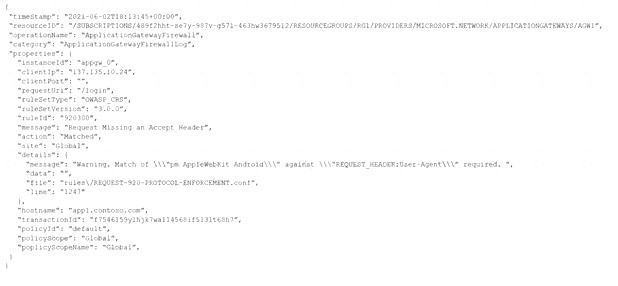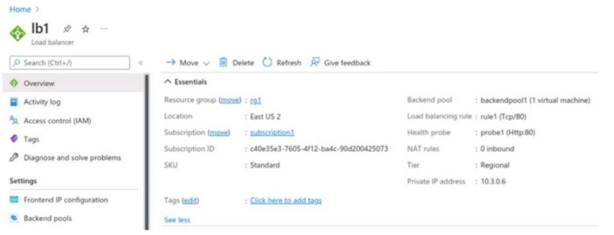- (Exam Topic 3)
You have an Azure subscription that contains the following resources:  A virtual network named Vnet1
A virtual network named Vnet1 Two subnets named subnet1 and AzureFirewallSubnet
Two subnets named subnet1 and AzureFirewallSubnet  A public Azure Firewall named FW1
A public Azure Firewall named FW1 A route table named RT1 that is associated to Subnet1
A route table named RT1 that is associated to Subnet1  A rule routing of 0.0.0.0/0 to FW1 in RT1
A rule routing of 0.0.0.0/0 to FW1 in RT1
After deploying 10 servers that run Windows Server to Subnet1, you discover that none of the virtual machines were activated.
You need to ensure that the virtual machines can be activated. What should you do?
Correct Answer:
B
Reference:
https://ryanmangansitblog.com/2020/05/11/firewall-considerations-windows-virtual-desktop-wvd/
- (Exam Topic 3)
Note: This question is part of a series of questions that present the same scenario. Each question in the series contains a unique solution that might meet the stated goals. Some question sets might have more than one correct solution, while others might not have a correct solution.
After you answer a question in this section, you will NOT be able to return to it. As a result, these questions will not appear in the review screen.
You have an Azure application gateway that has Azure Web Application Firewall (WAF) enabled. You configure the application gateway to direct traffic to the URL of the application gateway.
You attempt to access the URL and receive an HTTP 403 error. You view the diagnostics log and discover the following error.
You need to ensure that the URL is accessible through the application gateway. Solution: You add a rewrite rule for the host header.
Does this meet the goal?
Correct Answer:
B
https://docs.microsoft.com/en-us/azure/application-gateway/rewrite-http-headers-url#limitations
- (Exam Topic 3)
Your company has an Azure virtual network named Vnet1 that uses an IP address space of 192.168.0.0/20. Vnet1 contains a subnet named Subnet1 that uses an IP address space of 192.168.0.0/24.
You create an IPv6 address range to Vnet1 by using a CIDR suffix of /48.
You need to enable the virtual machines on Subnet1 to communicate with each other by using IPv6 addresses assigned by the company. The solution must minimize the number of additional IPv4 addresses.
What should you do? To answer, select the appropriate options in the answer area. NOTE: Each correct selection is worth one point.
Solution:
:
Add IPv6 configuration to NIC. "Configure all of the VM NICs with an IPv6 address using Add-AzNetworkInterfaceIpConfig"
Source: https://docs.microsoft.com/en-us/azure/load-balancer/ipv6-add-to-existing-vnet-powershell
Does this meet the goal?
Correct Answer:
A
- (Exam Topic 3)
You have two Azure subscriptions named Subscription1 and Subscription2. There are no connections between the virtual networks in two subscriptions.
You configure a private link service as shown in the privatelinkservice1 exhibit. (Click the privatelinkservice1 tab.)
You create a load balancer name in Subscription1 and configure the backend pool shown in the lb1 exhibit.
(Click tie 1b1 tab.)
You create a private endpoint in Subscription2 as shown in the privateendpoint4 exhibit. (Click the privateendpoint4)
For each of the following statements, select YES if the statement is true. Otherwise. select No.
Solution:
Yes, Yes, No
Does this meet the goal?
Correct Answer:
A
- (Exam Topic 2)
Which virtual machines can VM1 and VM4 ping successfully? To answer, select the appropriate options in the answer area.
NOTE: Each correct selection is worth one point.
Solution:
Text Description automatically generated
Box 1: VM2, VM3 and VM4.
VM1 is in VNet1/Subnet1. VNet1 is peered with VNet2 and VNet3.
There are no NSGs blocking outbound ICMP from VNet1. There are no NSGs blocking inbound ICMP to VNet1/Subnet2, VNet2 or VNet3. Therefore, VM1 can ping VM2 in VNet1/Subnet2, VM3 in VNet2 and VM4 in VNet3.
Box 2:
VM4 is in VNet3. VNet3 is peered with VNet1 and VNet2. There are no NSGs blocking outbound ICMP from VNet3. There are no NSGs blocking inbound ICMP to VNet1/Subnet1, VNet1/Subnet2 or VNet2 from VNet3 (NSG10 blocks inbound ICMP from VNet4 but not from VNet3). Therefore, VM4 can ping VM1 in VNet1/Subnet1, VM2 in VNet1/Subnet2 and VM3 in VNet2.
Does this meet the goal?
Correct Answer:
A

